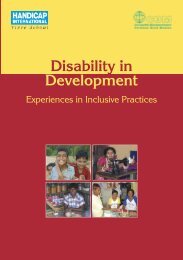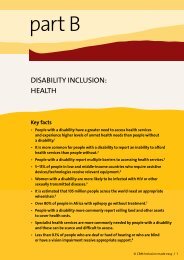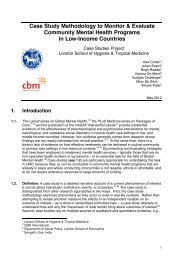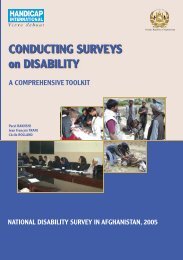Vision 2020 - World Health Organization
Vision 2020 - World Health Organization
Vision 2020 - World Health Organization
You also want an ePaper? Increase the reach of your titles
YUMPU automatically turns print PDFs into web optimized ePapers that Google loves.
VISION <strong>2020</strong> GLOBAL INITIATIVE FOR THE ELIMINATION OF AVOIDABLE BLINDNESS: ACTION PLAN 2006–2011<br />
8<br />
was projected to rise to only US$ 58 billion in <strong>2020</strong>, equivalent to an overall global saving over 20<br />
years of US$ 223 billion.<br />
Socioeconomic studies have shown that the prevention and treatment of avoidable blindness promote and<br />
accelerate progress towards a broader global development agenda, such as the Millennium Development<br />
Goals (Annex III). The direct links between the activities of VISION <strong>2020</strong> and human social and economic<br />
development must be strongly expressed and disseminated to decision-makers at all levels.<br />
1.4 ACHIEVEMENTS AND CHALLENGES<br />
Since its launch, more than 100 Member States have been directly involved in the activities of VISION<br />
<strong>2020</strong>. The participation of local eye health-care experts and planners in VISION <strong>2020</strong> workshops<br />
has increased awareness about public health concepts in eye care, and Member States have been<br />
encouraged to constitute national VISION <strong>2020</strong> committees in order to assess local needs, develop<br />
national action plans and facilitate their implementation, monitoring and periodic assessment (Annex<br />
IV). It is important that societies be made aware of known, well-tested, cost-effective interventions for<br />
preventing avoidable visual loss. Partner organizations of VISION <strong>2020</strong> have been active in encouraging<br />
the integration of comprehensive eye-care services into national health-care systems, by:<br />
• increasing political commitment to the prevention of visual impairment;<br />
• increasing professional commitment to the prevention of visual impairment;<br />
• increasing the provision of high-quality, sustainable eye care;<br />
• increasing public awareness and use of eye health-care services; and<br />
• encouraging the commitment and support of nongovernmental organizations and the private<br />
sector.<br />
Impressive successes in the prevention of blindness (for example in Gambia, India, Morocco, Nepal,<br />
Philippines, Sri Lanka and Thailand) testify to the commitment of local VISION <strong>2020</strong> partners and<br />
demonstrate the impact and potential of this global initiative.<br />
The initiative does not, however, operate in a static environment. As the world’s population continues<br />
to change, so do the extent, causes and distribution of blindness and visual impairment. As more,<br />
better data become available from population-based studies, more accurate estimates can be made<br />
of the extent of the problem and the patterns of causes in different countries and regions, adding to<br />
the agenda of VISION <strong>2020</strong>. As the prevalence of noncommunicable chronic eye diseases continues<br />
to grow substantially, global disparities in the availability of eye health-care services will continue<br />
to obstruct the prevention and control of avoidable blindness and low vision in the most populated,<br />
poorest parts of the world. To these challenges must be added the entrenched disparities in the allocation<br />
and availability of human and fi nancial resources. Without the resources needed to implement<br />
national VISION <strong>2020</strong> plans for the prevention of blindness, there is a real danger that the momentum<br />
that has been built to eliminate avoidable blindness will be lost, which would impede opportunities<br />
to scale-up comprehensive, sustainable eye-care services as part of strengthened health systems.<br />
Provision of services for underserved groups such as the poor, ethnic minorities and women is linked<br />
to the development, adoption and implementation of adequate health-care policies.<br />
These are only some of the issues facing the VISION <strong>2020</strong> initiative. Despite recent achievements in<br />
the prevention and control of avoidable blindness and low vision, considerable challenges remain that<br />
will require sustained, imaginative, concerted action. The achievements and limitations to date and<br />
strategies and recommendations for further implementation are described in detail in the following<br />
sections.

















